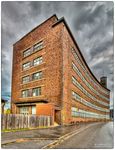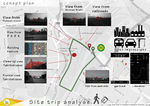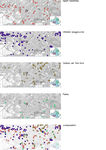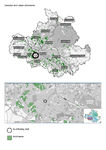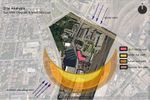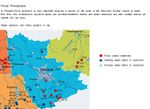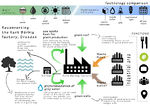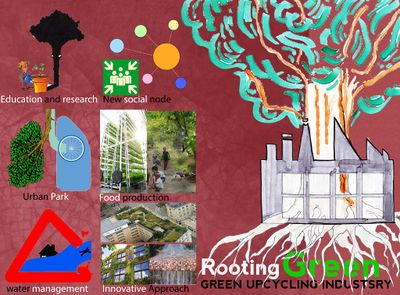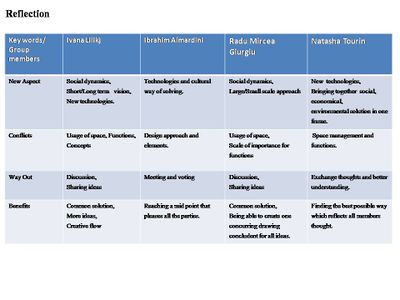Collaborative Green Infrastructure Design Group A
---> back to group page working group A
Kurt Bärbig Hall
| Name | Kurt Bärbig Hall | |
| Country | Germany | |
| City | Dresden | |
| Authors | Radu Mircea Giurgiu | |
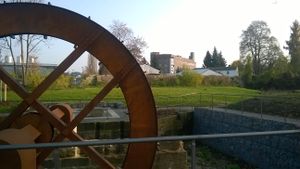
| ||
|
| ||
Landscape and/or urban context of your case
- Biogeography, cultural features, overall character, history and dynamics
- Illustrations: maps; sketches; short descriptive analyses
Dresden
(German pronunciation: [ˈdʁeːsdən]; Upper Sorbian: Drježdźany) is the capital city[2] of the Free State of Saxony in Germany. It is situated in a valley on the River Elbe, near the Czech border. The Dresden conurbation is part of the Saxon Triangle metropolitan area with 2.4 million inhabitants.[3]
Dresden has a long history as the capital and royal residence for the Electors and Kings of Saxony, who for centuries furnished the city with cultural and artistic splendor. The city was known as the Jewel Box, because of its baroque and rococo city center. The controversial British and American bombing of Dresden in World War II towards the end of the war killed approximately 25,000, many of whom were civilians, and destroyed the entire city center. The bombing gutted the city, as it did for other major German cities. After the war restoration work has helped to reconstruct parts of the historic inner city, including the Katholische Hofkirche, the Semper Oper and the Dresdner Frauenkirche as well as the suburbs.
Before and since German reunification in 1990, Dresden was and is a cultural, educational, political and economic center of Germany and Europe. The Dresden University of Technology is one of the 10 largest universities in Germany and part of the German Universities Excellence Initiative.' (Wikipedia
Dresden is one of the greenest cities in all of Europe, with 63% of the city being green areas and forests (Wikipedia)
Having this reputation the contrast of the small industrial area in the west part of the city strikes one as a strong contrast and give a sence of alteration in the urban canvas of the capital of Saxony.
Site Location
- Architect: Kurt Bärbig
- Great Garage: Karl Schmidt
- Construction period: 1927-1930
- Vacancy: since 1991
- Address: Fabrikstraße 13 01159 Dresden
51.039080, 13.707983
"The production buildings connected by a tunnel with a depot on the opposite side of the street has been designed as the first part of a not completed because of the world economic crisis the complex production of food (bakery, brewery, and distillery). The building consists of two six-story, one another at an obtuse angle vanes arranged and an eight-story tower. The equipped with loading ramps, convex Hofseiten are straight and the concave road adaptive front opposite. the framed by cornice window bands are street side led around by a five-story staircase, the street front on the formed by the two wing apex also extended. The system is designed according to principles Objectivity in disguise with red brick steel frame. It was changed after war damage and gutted in 1995." (G. Lupfer et.al. 1997)
Material: Red Brick
Sandstone, stone, plaster are known as typical facade materials in Saxony. Brick, brick, clinker is associated with North Germany, Hanseatic cities such as Lübeck and Hamburg. In the Saxon cities of Dresden, Leipzig and Chemnitz but there are several notable buildings, ensembles and settlements in the early decades of the 20th century, which are influenced by the material of clinker with its various ochers, reds, browns - a building material that can be considered more sustainable chances. (Ehem. Fleischverarbeitungsbetrieb der Konsumgenossenschaft "Vorwärts" Gelungene Symbiose von Schönheit und Zweckdienlichkeit )
"As a result of an architectural competition to build a new meat factory in Dresden was built Löbtau. As part Nahmer the Bauhaus director Walter Gropius and the successful Dresdner Office Schilling and Gräbner also had lined up. (...) Due to the consistency with which Bärbig designed by the great shape of the factory, he clearly approaches the ideals of dynamic architecture, whose protagonists in these years, Erich Mendelsohn belonged. Bärbig decreases with basic elements of dynamic functionalism terms of Mendelsohn's Schocken department store in Stuttgart. The largely remained unknown architect is thus the author of a typical twenties and in the Saxon metropolis unusually consistent factory building. "(H.C. Schink and T. Richter. 1997).
Kurt Bärbig 1889 - 1968
In 1923 he was appointed as the sole architect of Dresden in the German Academy for Urban. Bärbigs progressive, characterized by social aspects of urban and landscape design pays homage to the spirit of the times of objectivity, material relatedness and an effort to "Created time". Born in Dresden in 1889 architect who immigrated to Brazil in 1934 and came to the ruined city of the communist zone of Germany after 1945 back. In 1952, he was Head of freelance architects in the competition for the redesign of Dresden. In addition to Schneider and Rascher himself had e.g. Bärbig also involved in the competition for the new Market Square, but was eliminated at the first attempt.
Threatening problems
Flood: "Widespread across Saxony, the extreme flood of August 2002 led to massive damages, which could not be fully remedied to date. Besides reconstruction, numerous measures have been taken to provide for protection from future floods. Nevertheless, absolute security will never be guaranteed. Taking action responsibly in the regions at risk is an important key component of flood prevention." (Flood Trail Elbe in the Region of Dresden)
Food Security: The floods or other climatic events can result in poor crop yields and threaten the food security of the city.
Lack of Green in Industrial Area: Although projects of GI techniques are planned on a long term, the industrial area is still dominated by big buildings, lack of green space, and an uninviting environment for the community and visitors
History and Culture: The Food Production factory failed due to the World Economic Crisis from 1920, but the fact that is not now active with any function, may lead to losing the cultural heritage that the Architect Kurt Bärbig left behind.
- Illustrations
What are the overall objectives of your design? What are the specific objectives for enhancing green infrastructure?
Please give a short written argumentation (not more than 150 words). It is ok if you have different or even contradicting objectives within your group. Just make it explicit at the beginning of your process
The main objective of this project is to reactivate the abandoned factory that is an important architectural heritage of the city's architect from the 1920s, Kurt Bärbig. The means of doing that are harnessing the high potential of being a landmark, giving functions of food production, education and pylon in Green Infrastructure strategy. The factory should be linked with important sites of the city and should bring more green in the grey industrial area. An important strategy for the developing of the factory is using the resources in a smart way through integrating GI technologies. We want to find ways of using all available resources(river, active factories) in a smart way, and integrating the project in the site context.
Analytical drawings
Please add four analytical sketches/drawings (or montages/schemes) of your case. Every group member needs to contribute at least one drawing.
- Analytical Drawings
Projective drawings
Please add four projective sketches/drawings (or montages/schemes), of course with an emphasis on green infrastructure aspects. Every group member needs to contribute at least one drawing representing his/her individual ideas.
- Projective Drawings
Design Synthesis
For the Design synthesis we decided to work together on a single drawing. This was because of the ppt layout and it turned out to be a great collaborative process where we had to choose the points we agreed on to add to the Poster. Some worked on the drawing but everyone came with ideas and feedback until we reached the final poster. This helped understanding each individual point of view on the site and prooved that working in a team with different focuses on Green Infrastructure can lead to a complete and complex solution that is agreed by all parts.
- Design Synthesis Drawings
Summary of the collaborative process
We had a good collaboration with regular online meetings due to the fact that we all were living in Germany at the time of the seminar. We even created a separate work group on facebook where we shared ideas, and gave instant feedback to whatever things related with the seminar. We had different ideas on the site that we chose to work on, but we had good discussions on it that helped us find common grounds. In the end a successfull collaboration work was culminated with the Design synthesis drawing which shows that we could come up with a single comprehensive solution on our site.
- Table of contribution
Image Gallery
You may add a series of images/photos in addition to the sketches/drawings
- Image Gallery
References
* Please make sure that you give proper references of all external resources used.
* Do not use images of which you do not hold the copyright.
* Please add internet links to other resources if necessary.
- E. and D. Despommier. 2008. The Vertical Farm – The origin of a 21st Century Architectural Typology. Ellingsen, Issue III. CTBUH Journal. pp. 26-34
- G. Lupfer. B. Sterra. M. Wörner. J. Paul. C. W. Offermann. 1997. Architekturführer Dresden. Architectural Guide Dresden. Broschiert
- H. C. Schink; T. Richter. 1997. Industriearchitektur in Dresden. Deutscher Werkbund Sachsen, Leipzig
- http://www.luda-project.net/pdf/Dresden.pdf, last accesed 18.11.2014
- http://www.luda-project.net/pdf/LUDA_D13_Dresden1.pdf, last accesed 18.11.2014
- http://en.wikipedia.org/wiki/Dresden, last accesed 18.11.2014
- http://tu-dresden.de/die_tu_dresden/fakultaeten/fakultaet_architektur/ibad/denkmalpflege/studienarbeiten/ws_11_12, last accesed 18.11.2014
- http://www.huffingtonpost.com/2013/06/06/europe-floods-reach-dresden_n_3396105.html, last accesed 18.11.2014
- http://www.hochwasserlehrpfad-dresden.de/downloads/FT-Report_en.pdf, last accesed 18.11.2014
- http://www.fao.org/giahs/giahs-sites/middle-east-and-central-asia/qanat-irrigation-systems-and-homegardens-iran/detailed-information/en/, last accesed 19.11.2014
- http://inhabitat.com/case-and-soms-amps-living-green-wall-promises-to-reduce-air-pollution-and-energy-costs/, last accesed 19.11.2014
- http://www.lavasa.com/, last accesed 19.11.2014
- http://www.interpublic.com/about/sustainability?work_id=2290&casename=Draftfcb+Designs+Billboard+that+Produces+Drinking+Water, last accesed 19.11.2014
- http://en.wikipedia.org/wiki/Bosco_Verticale, last accesed 19.11.2014
- http://www.archdaily.com/585254/vincent-callebaut-s-2050-parisian-vision-of-a-smart-city/,last accesed 12.01.2015
- http://www.das-neue-dresden.de/fabrik-konsumgenossenschaft.html
- http://deu.archinform.net/projekte/6112.htm
- http://deu.archinform.net/arch/3003.htm
- http://de.wikipedia.org/wiki/Kurt_B%C3%A4rbig
- http://tu-dresden.de/die_tu_dresden/fakultaeten/fakultaet_architektur/ibad/denkmalpflege/studienarbeiten/ws_11_12
- http://www.lumabytes.com/suche/
- http://landarchs.com/permeable-paving-essential-guide/
- http://www.urban-project.lviv.ua/php_uploads/data/articles/ArticleFiles_84_Gleichmann_en.pdf
- http://www.luda-project.net/pdf/LUDA_D13_Dresden1.pdf
- http://www.dresdner-gartenfreunde.de/
- http://www.dresden.de/media/pdf/infoblaetter/kleingartenvereine_0206.pdf
- http://stadtplan2.dresden.de/%28S%280wmr2hhwkki2tg5sfng3o141%29%29/spdd.aspx
- http://www.dresden.de/media/pdf/mobilitaet/VEP_Tafeln_engl_History_of_Dresden_Transport_Planning.pdf
- http://www.mgipu.hr/doc/05_Hans_Martin_Pfohl.pdf
About categories: You can add more categories with this tag: "", add your categories

